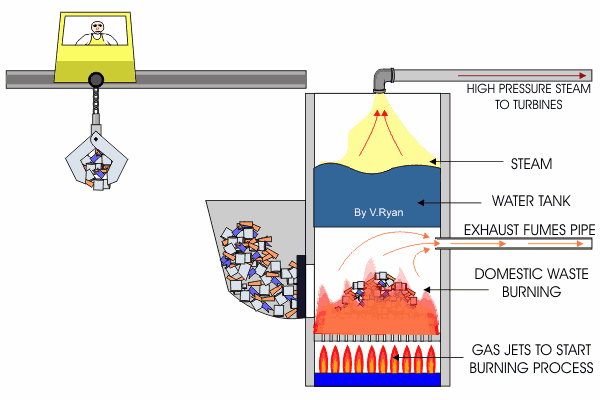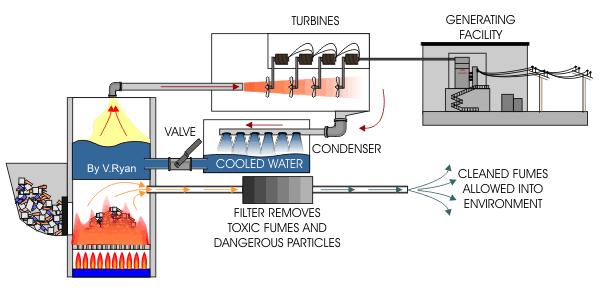| |
| CLICK HERE FOR INDEX PAGE |
| |
| BIO-FUELS - BURNING DOMESTIC WASTE |
| V. Ryan © 2006 - 2009 |
| |
| PDF FILE - CLICK HERE FOR PRINTABLE WORKSHEET |
| |
| Recently interest has grown in the burning of garbage
/ domestic waste to produce electricity. This is not a new idea although
in the past when waste was burned it created pollution that could even
be toxic. Today, the technology exists to remove almost all the
pollutants from the fumes produced during the energy production cycle.
Special filters remove dangerous chemicals and particles that would
normally be found in the fumes. |
| |
| 1. The domestic
waste is sorted usually by hand to remove materials than can be
recycled. Steel is removed using electromagnets and this is stored until
there is enough quantity for recycling to be economically viable.
Aluminium, in the form of cans is removed by hand. Other recyclable
materials are collected separately. These include, garden waste,
newspapers, cardboard, bottles, waste food and even used batteries. |
| |
 |
| |
|
|
| |
| 2. The waste is
then ‘dropped’ into the hopper of a furnace. When the doors slide open
it falls into the burning chamber. Gas is normally used to start the
fire which burns at a high temperature, destroying the domestic waste. |
| |
 |
| |
| Whilst the waste burns it heats a water tank, in
turn, producing steam. The steam is used to turn turbines, producing
electricity. |
| |
|
|
| |
| Once steam has been produced, the production of
electrical power is no different than that used in any other power
station. The high pressure steam is used to turn electrical turbines
which produce electricity. The advantage of this way of producing
electricity is that the domestic waste that would normally be buried in
land fill sites or even dumped far out at sea, is burned. This means
that vast areas of land that would have to be used for land fill are
free for agriculture or for building. |
| |
 |
| |
| SUMMARY OF PROCESS |
| |
| The domestic waste is burned in the furnace. This
heats water in a tank producing steam. The high pressure steam is used
to turn turbines, producing electricity. The steam produced during the
process condenses back to water and is recycled for heating once again.
Pollutants are removed from the fumes before they are allowed into the
atmosphere. |
| |
|
|
| |
| CLICK HERE FOR TECHNOLOGY AND ENVIRONMENT INDEX PAGE |
| |
| |
| |





